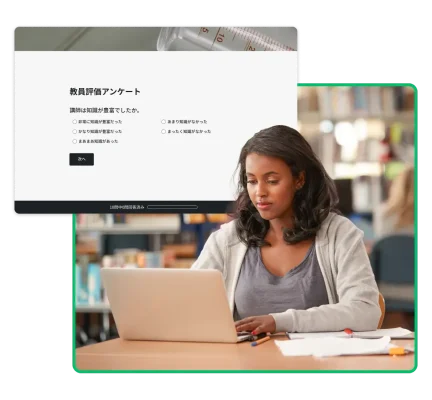
公正で質の高い学生フィードバックを得ることは、教え方を改善する効果的な手段であり、成長への意欲をきちんと実行に移すための絶好の機会です。教員評価アンケートの目的は、教員のパフォーマンスに対する学生の評価を測定するだけではなく、教員が教え方を改善し、学びの足りない部分を補えるようにすることです。
教員評価アンケートとはどのようなものか、なぜ正しく実施することが大切なのかを見ていきましょう。教員評価フォームを使って学習成果を改善し、さらにキャリアアップする方法もご紹介します。
教員評価とは
教員評価では、教員のパフォーマンスと有効性を測定します。
それには、たとえば管理者や同僚が授業中の教員を観察するなどの方法があります。教員評価アンケートを使って教員のパフォーマンスを測定すれば、観察を補足することができます。
たとえば、高校の校長が生徒に定期的にアンケートを送信し、フィードバックを求めるケースなどが考えられます。
教員を評価する理由
授業の質を改善するためには、まずどこを改善する必要があるかを理解しなければなりません。教員評価、特に生徒を対象に実施する教員評価では、行動を起こすために有益なインサイトが集まります。
授業の有効性を証明する
教員評価では、指導の効果が明らかになるため、うまく機能したやり方を再現し、生徒の心に響かないものを見直すことが可能になります。
実際に、スタンフォード大学の調査から、教員の有効性がその学年度内に改善されただけでなく、評価の後も数年にわたって改善されたことが判明しています。
もちろん、評価は、生徒の学習成果にとって有益なだけではありません。収集したデータは、教員の成長を証明し、キャリアアップにつながることもあります。たとえば、生徒の成績が良く、教員評価が高ければ、教員の昇進を後押しするでしょう。
学生体験を改善する
ツールやサポート、資金の不足を特定して、生徒の理解や授業への集中を改善します。テストの点は、生徒のパフォーマンスを示す強力な指標と考えられていますが、必ずしも教員の有効性を示すものではありません。そのギャップを埋めるのが、教員評価です。
たとえば、生徒がある教科のテストで高得点を取ったのに、「授業の内容をどの程度理解していますか」と聞かれて「よく理解していない」と答えることがよくあります。このような場合、教員は、テストに向けて生徒を準備する作業はうまくこなしたものの、生徒がより深く内容を理解できるように支援するという点で力不足だったことがわかります。
教員は、生徒に丸暗記させるのではなく、内容をよく理解してもらえるようサポートすることに時間とエネルギーを注ぐ必要があります。
継続的な学習の機会を特定する
教員評価では、教員としての成長の必要性を明らかにし、指導能力の改善につながるトレーニングやリソースを見つけることが可能になります。たとえば、生徒のアンケートを実施した結果、教室で使用する資料が、ハンディキャップのある生徒には使いにくいということに学校管理者が気づく場合があります。そうであれば、教員を対象にトレーニングを行い、生徒のニーズに合った教材を準備できるようにする必要があります。
注: 教員が継続的に研修を受けることは、有意義なだけでなく、法律上の義務でもあります。教員は、2年おきに特定時間数の講習を受けないと教員免許を維持・更新することができません。

生徒向け教員評価アンケートの14の質問
教員評価の例をご覧になりたい方のために、教員評価アンケートでよく使われる質問例をご紹介しましょう。
- 講師は知識が豊富でしたか。
- 非常に知識豊富だった
- かなり知識があった
- いくぶん知識があった
- あまり知識がなかった
- まったく知識がなかった
- 講師は講義目的について明確に説明しましたか。
- 極めて明確
- とても明確
- まあまあ明確
- あまり明確ではない
- まったく明確ではない
- 本日のワークショップの講師をどのように評価しますか。
- すばらしい
- とても良い
- まあまあ良い
- あまり良くない
- まったく良くない
- 講師は学生の質問に適切に答えていましたか。
- 大いに当てはまる
- かなり当てはまる
- まあまあ当てはまる
- あまり当てはまらない
- まったく当てはまらない
- この授業で出る課題は、簡単でしたか、難しかったですか。
- 簡単すぎた
- 簡単だった
- 妥当
- 難しかった
- 難しすぎた
- 宿題は講義内容の理解に役立ちましたか。
- 非常に役に立った
- かなり役に立った
- そこそこ役に立った
- あまり役に立たなかった
- 全く役に立たなかった
- 次の文にどの程度同意しますか。「このコースを通じて、テーマについて多くのことを学ぶことができた。」
- そう思う
- どちらかと言えばそう思う
- どちらとも言えない
- どちらかと言えばそう思わない
- そう思わない
- 質問や問題の解決にたどり着くプロセスは、どの程度簡単でしたか。
- 非常に簡単
- かなり簡単
- やや簡単
- あまり簡単でなかった
- 少しも簡単でない
- 講師は講義目的について明確に説明しましたか。
- 極めて明確
- とても明確
- まあまあ明確
- あまり明確ではない
- まったく明確ではない
- 講師は授業計画にどの程度従っていましたか。
- 大いに当てはまる
- かなり当てはまる
- まあまあ当てはまる
- あまり当てはまらない
- まったく当てはまらない
- 講師が講義を進めるスピードは、速すぎましたか、遅すぎましたか、妥当でしたか。
- かなり速すぎた
- 速すぎた
- 妥当
- 遅すぎた
- かなり遅すぎた
- コースのうち、最も気に入った・気に入らなかったのはどの部分ですか。
- この講師は、興味深い授業にするためにどのような工夫をしていますか。
- 講師に伝えたいことは他にありますか。
注: 質問12~14は、自由回答形式であるため、回答が記述されます。
教員の有効性に関する質問
「講師は講義目的について明確に説明しましたか」、「講師は学生の質問に適切に答えられましたか」のような質問です。このような質問を使うと、教え方や課題が、知識を授けるという点で効果的だったかどうかを特定できます。
評価が匿名でない場合は、生徒の回答を成績や出席と合わせて追跡することができます。欠席が多かった生徒は、教員の有効性に関する質問にネガティブに回答しているかも知れません。そのような場合、出席を促進したり、家庭学習に役立つ参考書を紹介したりするのが改善への近道となります。
生徒の成長と能力開発に関する質問
生徒が授業でどの程度学んだかを調べる質問では、生徒の成長について把握することができます。次のような質問が含まれます。
- この授業で出る課題は、簡単でしたか、難しかったですか。
- 宿題は講義内容の理解に役立ちましたか。
- 次の文にどの程度同意しますか。「このコースを通じて、テーマについて多くのことを学ぶことができた。」
学習支援についても質問してみましょう。学習障害のある生徒や支援の必要な生徒、何らかの活動に従事しているために頻繁に欠席しなければならない生徒は、授業についていくために何らかの支援を必要としているかも知れません。
授業管理に関する質問
講師が授業をうまく管理できているかを調べるには、「この教員は、興味深い授業にするためにどのような工夫をしていますか」(自由回答形式)、「講師が講義を進めるスピードは、速すぎましたか、遅すぎましたか、妥当でしたか」のような質問をします。
適切な授業管理は、生徒の学習と成長を支える環境をつくります。それだけでなく、効果的に授業を管理することで、教員の定着率も向上します。
米国のランド研究所の調査によれば、「公立学校の教師が早期退職する最大の理由はストレス」ということがわかっています。管理が行き届いた授業は、効率的で雰囲気が落ち着いているため、生徒と教師の両方が負担を感じません。
これらの質問に対する回答は、教員が自分の管理スキルを振り返り、教室での気構えや感情を把握するのに役立ちます。
教員評価の5つの課題と制限
教員評価は、完璧なソリューションではありません。補う必要のある弱みがいくつかあります。よくある問題とその解決方法をご紹介しましょう。
1. 回答しない生徒がいる
生徒の中には、教員評価に参加する気がない生徒がいます。次のようなケースが考えられます。
- 授業の終わりや学期末には、すでにやる気が低下している
- 他の勉強で忙しい(特に評価を期末テスト期間に実施した場合)
- アンケートに答える行為が苦痛
アンケートへの回答を授業の必須要件にしても、逆効果になる場合があります。ただ完答するためだけにランダムに答えを書き込んだり、参加を強制されたことに嫌気がさし、実際より批判的に回答したりする人が出るでしょう。完答しなかったケースを把握し、それぞれの条件に合わせて完答を促すようにしましょう。
2. 匿名か記名か
アンケートを実施するときは、匿名か記名かを選ばなければなりません。どちらにも、それぞれ長所と短所があります。記名アンケートでは、生徒が正直に回答しない可能性があります。反応をおそれたり、確認の連絡を受けたくないと考えたりするためです。
アンケートを完全に匿名にすれば、より率直な回答が得られるだけでなく、回答率も高まります。正直なデータが得られるという点では、匿名アンケートの方が優れています。
しかし、匿名アンケートでは、正確な結果が得られるものの、外れ値を特定することはできません。たとえば、懲戒処分の対象となる生徒や、出席率が低かった生徒の回答を除外することができません。
3. アンケートが長い
詳細で実用的なフィードバックを得ようと、包括的なアンケートを作成すると、生徒が途中で疲れてしまう場合があります。たくさんの質問が並んでいるのを見て、さっさといい加減に答えたり、選択肢を適当に選んだり、途中でやめたりする生徒が出てきます。これは、データの品質や有効性を著しく損なう行為です。
このような行為を防ぐためには、生徒の学年や能力、目標を念頭に置いてアンケートを作成する必要があります。たとえば、中学生であれば、大学生より集中力が続く時間が短いと考えられます。アンケートの長さや内容を、年齢と能力に適したものにすることが大切です。
したがって、主要な項目に焦点を絞った、短いアンケートの方が、年齢に関係なく丁寧で有意義な回答を得ることができます。教え方のうち、最も改善したい部分、最も評価が知りたい部分は何かを念頭に置き、それに関連した質問をしましょう。最終的には、常に明確でシンプルなアンケートを心がけることが重要です。
4. 評価サイクルが一定でない
一部の教育機関では、教員評価の実施が定期的でなく、教員の進歩や成長を長期的に追跡するのが難しい場合があります。
理想的なのは、授業のたびに評価を実施することです。また、評価は、学期が変わっても一貫している必要があります。質問を大幅に変えてしまうと、教員のパフォーマンスが比較しにくくなり、成長のトレンドや領域が特定できなくなります。
5. 内在的なバイアス
米国のオンライン出版サイトであるInside Higher Edによると、教員評価は、「女性教員に対する学生の評価など、ジェンダーバイアスの問題に直面する」可能性があります。他にも、次のようなバイアスが生じるおそれがあります。
- 個人的な偏見: 生徒が教員を個人的な理由で強く嫌ったり好んだりする
- 人種的な偏見: 教員の才腕を判断する際に人種の影響を受ける
- 主観バイアス: 教員の才腕の評価が教科の好き嫌いに左右される
米国のAssessment & Evaluation in Higher Education(高等教育におけるアセスメントと評価)で発表されている調査では、バイアスを減らすために、独立した評価者、生徒への聞き取り、専門家による授業の観察、同僚による指導資料とアンケートスコアの確認を組み合わせて行うことが推奨されています。
教員評価フォームの作成方法
教え方やコースについて生徒がどう思っているかを調べる一番の方法は、聞いてみることであり、それを最も簡単に行う手段が教員評価アンケートです。
評価アンケートを生徒に送信することで、生徒に発言の機会を与え、注目すべきトレンドや問題を特定することができます。
準備はできましたか。教員評価アンケートを使って、生徒からフィードバックを集めるための4つのステップをご紹介しましょう。
アンケートの目的と目標を説明する
まず、このアンケートをなぜ生徒に送るのかを話し合います。データをどのように分析し、どのように行動に移すか、正直に答えてもらうことがなぜ大切なのかを説明しましょう。
評価における教員個人の目標を詳しく説明することをお忘れなく。自分の能力を改善するだけでなく、生徒の改善もサポートすることなどです。アンケートに匿名で回答することが可能かどうか、教頭や同僚など、他の人が結果を見ることがあるかなどを、前もって率直に伝えます。
ヴァンダービルト大学の教育センターは、授業計画の中でアンケートの実施に言及することを提案しています。そうすれば、アンケートがコースの一部であることを強調できるので、生徒が教室での体験により注意を払うようになります。また、前もって心の準備ができるため、アンケートの実施時に完答してもらえる可能性が高くなります。
適切な質問をする
どうすれば、生徒から貴重なフィードバックを引き出すような質問が作成できるでしょうか。まず、自分が教員評価に何を期待しているのかを考えてみましょう。
- 生徒が自分の教え方についてどう思っているか、遠慮なく質問ができると感じているかを把握したい
- コースの作業量やペース、課程について詳しく調べ、フォローアップとして指示に関する質問をしたい(その場合は、コース評価テンプレートが役立ちます)
授業や生徒との関係を改善するために何が必要なのかを検討します。アンケートを最大限に活用するためには、さまざまな質問タイプを混ぜることが大切です。テキストボックスを使った自由回答形式の質問も用意しましょう。
たとえば、SurveyMonkeyの教員評価テンプレートには、複数選択肢の質問が多く含まれていますが、生徒は最後に「この講師を特に高く評価できる点はありますか」、「この講師に改善すべき点はありますか」という質問に自由に答えることができます。
生徒に自分の言葉で回答してもらうことで、アンケートで扱っていないテーマに触れる機会を提供することになります。それでも、質問の大部分が選択回答形式であるのが望ましいです。文章で回答するのは、時間も手間もかかるため、自由回答形式の質問が多いと生徒たちが面倒くさがって回答しない可能性があります。
トレンドを押さえてデータに基づいた変更を行う
生徒からのフィードバックを評価する作業は、容易ではありません。オープンマインドな姿勢でアプローチし、改善の機会となりそうなパターンを探すことが大切です。
たとえば、データから、生徒の80%が特定の課題に苦労していることが判明したなら、課題を出すときの説明や要求事項、関連する授業の内容などを見直すことを考えましょう。
今後のためにベンチマークを設定する
教員評価アンケートの実施を習慣にしましょう。コースの終わりだけでなく、学期の半ばに行うことも検討します。そうすれば、コースが終わる前に問題に対処したり、前半の結果と後半の結果を比較したりできます。このような比較を行うと、自分の進歩を追跡し、今後の評価における目標を設定することができます。

その他の教員評価の例とリソース
アンケートは、包括的な教員評価を行うための優れた手段です。教員の評価は、別の内容を指す場合もあるので注意が必要です。たとえば、広く普及している教員評価アプリは、大学の推薦型選抜に申し込む生徒を教師が評価するものです。
カスタマイズ可能な教育アンケートテンプレートを確認して、今すぐ始めましょう。あるいは、SurveyMonkeyを使って教員評価の指針を作成し、生徒からフィードバックを集め、授業を改善する方法をご覧ください。
その他のリソースを見る

それぞれの役割に合ったソリューション
SurveyMonkeyが仕事の効率化をお手伝いします。成功する戦略・製品・体験で影響力を最大化する方法をご覧ください。

オンライン評価フォームで実用的なフィードバックを集める
オンライン評価フォームを作成・カスタマイズ。構造化されたフィードバックの収集、パフォーマンス評価、データに基づいた意思決定が簡単になります。

保育所登録フォームテンプレート
SurveyMonkeyの保育所登録フォームテンプレートで登録プロセスを単純化。直感的なフォームビルダーで必要に合わせてカスタマイズできます。

同窓会登録フォームテンプレート
同窓会登録フォームテンプレートで同窓生との繋がりを保ちましょう。直感的なフォームビルダーで必要に合わせてカスタマイズできます。